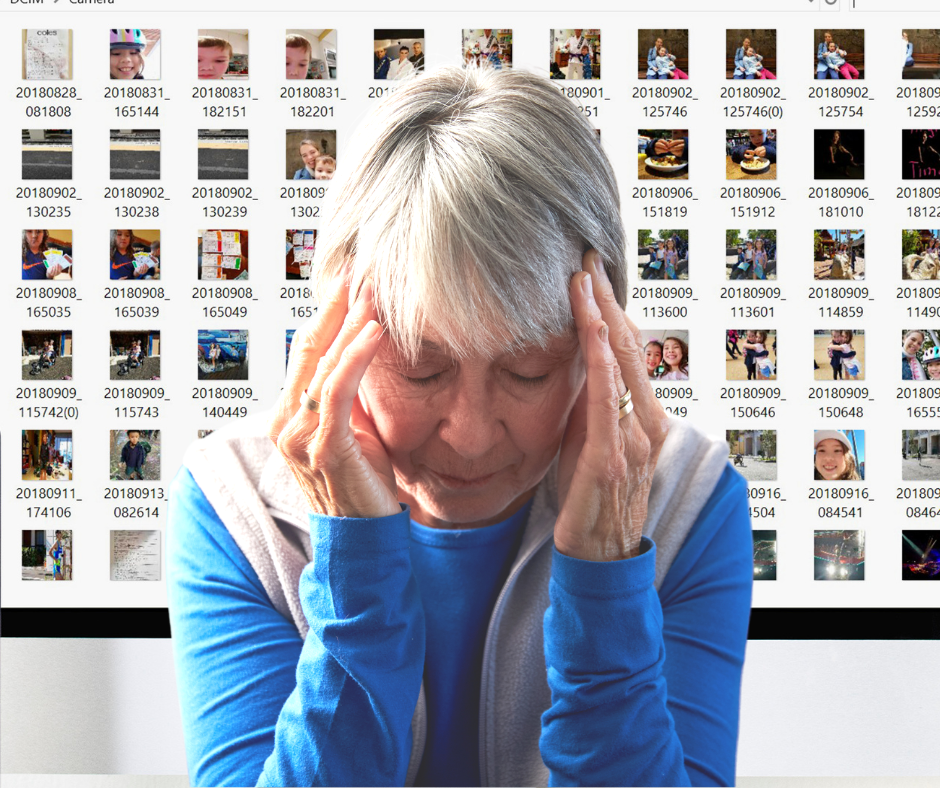
Nancy always loved taking photos. Her camera was her best friend, and she took it with her everywhere she went. Over the years, she had captured so many amazing memories – family vacations, birthdays, holidays, and so much more. Although she knew she should organize and safeguard her photos, she never prioritized sorting out her digital photos.
But one day, her computer crashed, and she lost everything. All of her photos were gone.
Nancy was devastated. In hindsight, she wished she had taken the time to organize and protect her precious memories.
Unfortunately, Nancy’s story is not uncommon. Despite knowing that we should take better care of our precious photos, we often put it off, waiting for the “right time.”
We are smart people. We know that computers crash, hard drives fail, houses burn, and rivers flood. So logically, we should protect things that we love that are vulnerable to disaster. Yet we don’t.
I decided to investigate why we so often put “sort out my photos” in what a student of mine calls the “One Day Room”. And what we can do to simplify the process.
The Overwhelming Volume of Photos
One of the biggest challenges is the sheer volume of photos. It’s super easy to take hundreds of photos in one day, and before we know it, we have thousands of pictures stored on our devices. This makes it difficult to find specific photos or organize them in a meaningful way.
We might remember taking a great picture of our family on vacation, but finding it among thousands of other photos can be a frustrating experience. And this frustrating experience creates the belief that if one photo is so hard to find, then sorting out thousands of photos would be 1000 times more frustrating. So we don’t attempt it.
Lack of Time
Another reason why sorting out digital photos is a challenge is that we envision it to be super time-consuming and tedious. If you don’t use tools like software, going through all of our photos, deleting duplicates or unwanted pictures, and organizing them into folders or albums takes a lot of effort.
It’s easy to procrastinate and put it off until another day, especially when we have other priorities in our busy lives. Additionally, it can be hard to stay motivated to complete the task when it feels overwhelming.
It is an Emotional Project
Ever decluttered your bathroom? It is super easy and not generally emotionally taxing. You throw out the old makeup, medicine, towels, etc. Clean the surfaces and tidy up the shower. Toss old shampoo bottles and you are done.
Now compare that to going through your children’s school work, art projects, or baby clothes. Every single item holds some memory or emotion. You hold on to each one, or smell that little hat, and you are sent right down memory lane. One little pile might take an hour to get through. And at the end, you are tired.
THAT is what organizing your photos feels like if you do it one by one.
Technology
We are bombarded by technology every day. There is always a new app, a new upgrade, a new thing to learn. The idea of learning new software or a new system can feel totally overwhelming (sensing a theme here?).
Plus there is the fear that we might appear foolish or unintelligent if we can’t pick it up right away. Or that the learning process might just add to frustration and not really relieve any of it.
So we get paralyzed in knowing technology does help some people accomplish this project fast but not being sure that you fit in that category.
Given all this, what is the solution so we don’t end up like Nancy?
By understanding the challenges we face, we can take steps to simplify the process of sorting out our digital photos.
The first is breaking down your priorities.
Which photos are more important to get sorted? Which ones are the easiest? What am I hoping to do with the photos? Taking inventory of all the places you have photos and asking questions like these can help you figure out where to start. Breaking down this task into manageable actions makes it much less overwhelming and actually doable.
Schedule the time
You have to set aside some time to make progress. Photo organizing is not something that happens in the in-between moments in your everyday. You need to schedule 20-30 minutes to take action. More if you can, as it is one of those tasks that once you get going, you will want to keep working at it.
For a lot of us with competing priorities, this time may feel selfish as it feels like something you are doing for you. But remember, who you are really doing it for. And they will totally thank you later.
Use tools that speed up the process
Software, external drives, computers, apps may all seem confusing, but you absolutely can learn how to automate your organizing process if you have the right teacher. The key is to find someone who teaches people with your skill set and needs. It may be that you feel like you have very little skills in this area – but there are instructors who teach “non-techie” people to use technology. I am one of them. Don’t let being scared of technology keep you from reaching your goals.
So don’t put off organizing and protecting your photos like Nancy did. With realistic expectations and some well-matched help, you can get your photos organized, backed up, and back to a place where you can experience the joy that you have captured in all these beautiful memories.
Click here to download my free Find Your Photos Workbook and get started.
You are also invited to join my free Facebook Group to learn more tips and tricks for getting your photos sorted.
